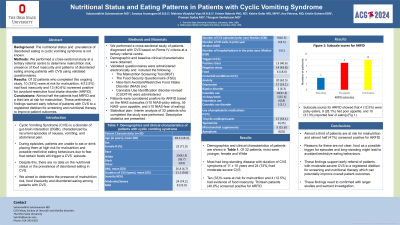Monday Poster Session
Category: Functional Bowel Disease
P2346 - Nutritional Status and Eating Patterns in Patients With Cyclic Vomiting Syndrome
Monday, October 28, 2024
10:30 AM - 4:00 PM ET
Location: Exhibit Hall E

Has Audio

Subanandhini Parameshwari, MD
The Ohio State University
Columbus, OH
Presenting Author(s)
Subanandhini Subramaniam, MD1, Saranya Arumugam, MBBS1, Mahima Vijaybhai Vyas, MBBS1, Kristen Roberts, PhD, RD2, Kebire Gofar, MD, MPH1, Kristin Goheen, 1, Praveen Goday, MD3, Thangam Venkatesan, MD1
1The Ohio State University, Columbus, OH; 2The Ohio State University Wexner Medical Center, Columbus, OH; 3Nationwide Children's Hospital, Columbus, OH
Introduction: Cyclic Vomiting Syndrome (CVS) is a disorder of gut-brain interaction (DGBI), characterized by recurrent episodes of nausea, vomiting, and abdominal pain. Episodes last several days to a week and frequency varies from 3 episodes/year to 2/month where patients are unable to eat or drink placing them at risk of malnutrition and possible restrictive eating. Despite this, there are no data on the nutrition status or the prevalence of disordered eating in CVS. We aimed to determine the presence of malnutrition risk, food insecurity and disordered eating among patients with CVS.
Methods: We performed a cross-sectional study of patients diagnosed with CVS based on Rome IV criteria at a tertiary referral center. Validated questionnaires including 1) The Malnutrition Screening Tool (MST) 2) the Food Security Questionnaire (FSQ) 3) Nine-Item Avoidant/Restrictive Food Intake Disorder (NIAS) and 4) Cannabis Use Identification disorder (CUDIT) were administered. Patients were considered positive for ARFID based on the NIAS subscales (≥10 NIAS-picky eating, ≥9 NIAS-appetite, and ≥10 NIAS-fear). Demographic and clinical data were also obtained. Statistical plan: Interim analysis of 32 patients who completed the study was performed. Descriptive statistics are presented.
Results: Demographics and clinical characteristics of patients are shown in Table 1. Of 32 patients, mean age was 39 ± 16, 23 (72%) were female. Most had long-standing disease with duration of CVS symptoms of 11 ± 10 years and 24 (74%) had moderate-severe CVS. Ten (33%) were at risk for malnutrition and 4 (12.5%) had evidence of food insecurity. Thirteen patients (40.6%) screened positive for ARFID. The subscale scores for ARFID showed that 4 (12.5%) were picky eaters, 9 (28.1%) had poor appetite, and 10 (31.3%) had fear of eating. Of those who screened positive for ARFID, 6 (46%) used cannabis primarily for relief of nausea.
Discussion: These preliminary findings of patients with CVS supports a high risk for malnutrition and ARFID. These could be related to long-standing disease and fear of eating leading to avoidant/restrictive eating behaviors. These findings support early referral of patients with moderate-severe CVS to a registered dietitian for screening and nutritional therapy which can potentially improve overall patient outcomes. These findings need to be confirmed with larger studies and warrant investigation.
Note: The table for this abstract can be viewed in the ePoster Gallery section of the ACG 2024 ePoster Site or in The American Journal of Gastroenterology's abstract supplement issue, both of which will be available starting October 27, 2024.
Disclosures:
Subanandhini Subramaniam, MD1, Saranya Arumugam, MBBS1, Mahima Vijaybhai Vyas, MBBS1, Kristen Roberts, PhD, RD2, Kebire Gofar, MD, MPH1, Kristin Goheen, 1, Praveen Goday, MD3, Thangam Venkatesan, MD1. P2346 - Nutritional Status and Eating Patterns in Patients With Cyclic Vomiting Syndrome, ACG 2024 Annual Scientific Meeting Abstracts. Philadelphia, PA: American College of Gastroenterology.
1The Ohio State University, Columbus, OH; 2The Ohio State University Wexner Medical Center, Columbus, OH; 3Nationwide Children's Hospital, Columbus, OH
Introduction: Cyclic Vomiting Syndrome (CVS) is a disorder of gut-brain interaction (DGBI), characterized by recurrent episodes of nausea, vomiting, and abdominal pain. Episodes last several days to a week and frequency varies from 3 episodes/year to 2/month where patients are unable to eat or drink placing them at risk of malnutrition and possible restrictive eating. Despite this, there are no data on the nutrition status or the prevalence of disordered eating in CVS. We aimed to determine the presence of malnutrition risk, food insecurity and disordered eating among patients with CVS.
Methods: We performed a cross-sectional study of patients diagnosed with CVS based on Rome IV criteria at a tertiary referral center. Validated questionnaires including 1) The Malnutrition Screening Tool (MST) 2) the Food Security Questionnaire (FSQ) 3) Nine-Item Avoidant/Restrictive Food Intake Disorder (NIAS) and 4) Cannabis Use Identification disorder (CUDIT) were administered. Patients were considered positive for ARFID based on the NIAS subscales (≥10 NIAS-picky eating, ≥9 NIAS-appetite, and ≥10 NIAS-fear). Demographic and clinical data were also obtained. Statistical plan: Interim analysis of 32 patients who completed the study was performed. Descriptive statistics are presented.
Results: Demographics and clinical characteristics of patients are shown in Table 1. Of 32 patients, mean age was 39 ± 16, 23 (72%) were female. Most had long-standing disease with duration of CVS symptoms of 11 ± 10 years and 24 (74%) had moderate-severe CVS. Ten (33%) were at risk for malnutrition and 4 (12.5%) had evidence of food insecurity. Thirteen patients (40.6%) screened positive for ARFID. The subscale scores for ARFID showed that 4 (12.5%) were picky eaters, 9 (28.1%) had poor appetite, and 10 (31.3%) had fear of eating. Of those who screened positive for ARFID, 6 (46%) used cannabis primarily for relief of nausea.
Discussion: These preliminary findings of patients with CVS supports a high risk for malnutrition and ARFID. These could be related to long-standing disease and fear of eating leading to avoidant/restrictive eating behaviors. These findings support early referral of patients with moderate-severe CVS to a registered dietitian for screening and nutritional therapy which can potentially improve overall patient outcomes. These findings need to be confirmed with larger studies and warrant investigation.
Note: The table for this abstract can be viewed in the ePoster Gallery section of the ACG 2024 ePoster Site or in The American Journal of Gastroenterology's abstract supplement issue, both of which will be available starting October 27, 2024.
Disclosures:
Subanandhini Subramaniam indicated no relevant financial relationships.
Saranya Arumugam indicated no relevant financial relationships.
Mahima Vijaybhai Vyas indicated no relevant financial relationships.
Kristen Roberts indicated no relevant financial relationships.
Kebire Gofar indicated no relevant financial relationships.
Kristin Goheen indicated no relevant financial relationships.
Praveen Goday indicated no relevant financial relationships.
Thangam Venkatesan: Takeda Pharmaceuticals – Consultant, Grant/Research Support.
Subanandhini Subramaniam, MD1, Saranya Arumugam, MBBS1, Mahima Vijaybhai Vyas, MBBS1, Kristen Roberts, PhD, RD2, Kebire Gofar, MD, MPH1, Kristin Goheen, 1, Praveen Goday, MD3, Thangam Venkatesan, MD1. P2346 - Nutritional Status and Eating Patterns in Patients With Cyclic Vomiting Syndrome, ACG 2024 Annual Scientific Meeting Abstracts. Philadelphia, PA: American College of Gastroenterology.
